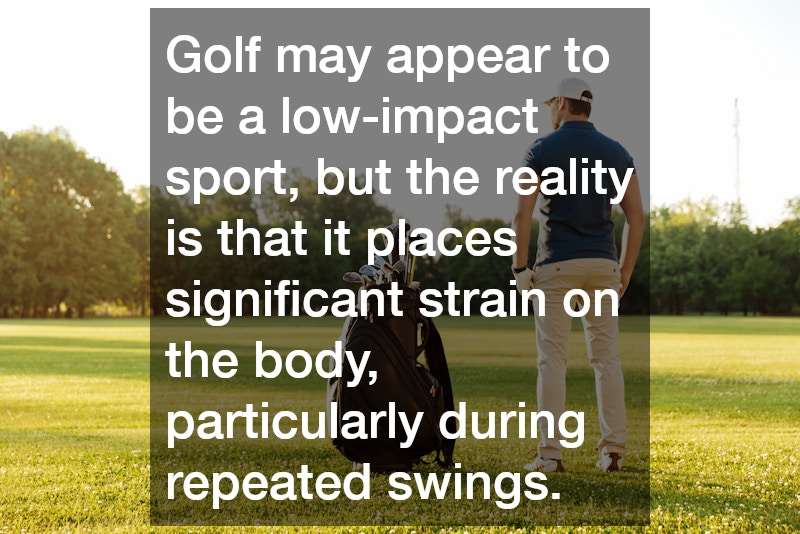Golf may appear to be a low-impact sport, but the reality is that it places significant strain on the body, particularly during repeated swings. The twisting, bending, and rotational forces involved in a golf swing can cause injuries if not managed properly. From lower back strains to wrist pain and shoulder issues, many golfers—both amateur and professional—find themselves sidelined by swing-related injuries. Fortunately, golf injury rehab provides an effective way to address these risks, helping players recover more quickly while preventing recurring problems in the future.
Understanding Swing-Related Injuries in Golf
The golf swing requires coordination between multiple muscle groups, joints, and movement patterns. Unlike sports with shorter bursts of movement, golf involves repetitive motions that can lead to overuse injuries.
Some of the most common swing-related injuries include:
-
Lower back pain: Caused by repetitive twisting and poor swing mechanics.
-
Shoulder injuries: Including rotator cuff strains from over-rotation or poor flexibility.
-
Wrist and hand pain: Often from gripping the club too tightly or hitting the ground before the ball.
-
Elbow issues: Such as golfer’s elbow, which results from overuse of the forearm muscles.
-
Hip and knee strain: Due to rotational stress during the swing and poor lower-body stability.
Recognizing these injury patterns is the first step toward developing a plan to reduce the likelihood of experiencing them.
The Role of Golf Injury Rehab
Golf injury rehab is not only about recovery after an injury occurs—it is equally focused on prevention. Through targeted exercises, stretching routines, and mobility work, players can strengthen the muscles used in golf and develop more balanced movement patterns. When the body is stronger and more flexible, it can withstand the physical demands of the swing without breaking down.
A rehab program for golfers typically includes:
-
Strength training for the core, shoulders, and hips to provide stability.
-
Flexibility exercises to improve range of motion in the spine, shoulders, and hips.
-
Balance and coordination drills to ensure proper weight transfer during the swing.
-
Corrective exercises to address muscle imbalances or poor posture that may contribute to injury risk.
By tailoring rehab strategies to the needs of each individual golfer, therapists help create a foundation for healthier and more efficient movement.
Why Prevention Is Better Than Recovery
In sports medicine, prevention is always preferable to treatment. Injuries not only disrupt play but can also cause long-term physical issues that limit future performance. A proactive approach through golf injury rehab allows players to strengthen weak areas before they become problematic. For example, a golfer with limited shoulder mobility may be at higher risk for rotator cuff injuries. Rehab can identify and address this limitation early, preventing a potentially serious setback.
Another benefit of prevention is improved swing mechanics. Rehab exercises often enhance posture, flexibility, and muscle coordination, which in turn leads to a smoother and more consistent swing. This means golfers don’t just avoid injury—they also play better.
Key Strategies in Golf Injury Prevention
-
Warm-Up and Cool-Down Routines
Many golfers skip warm-ups, heading straight from the parking lot to the tee box. This dramatically increases the risk of muscle strains. Simple stretches, dynamic movements, and light swings prepare the body for action and reduce injury risk. -
Core and Back Strengthening
Since the golf swing relies heavily on spinal rotation, the lower back is particularly vulnerable. Strengthening the core muscles provides essential support for the spine, reducing pressure during swings. -
Flexibility Training
Tight hips, shoulders, or hamstrings restrict swing range and place stress on joints. Flexibility programs improve mobility, enabling smoother motion with less strain.
How Professionals Personalize Rehab Programs
No two golfers have the exact same body mechanics or injury risks. Age, fitness level, swing style, and prior injuries all influence the design of a rehab plan. Physical therapists and sports medicine experts often start with an assessment of posture, flexibility, and movement patterns. From there, they develop a customized plan that addresses specific weaknesses and aligns with the golfer’s goals.
For example, an older golfer may focus more on flexibility and joint health, while a competitive player may prioritize power, stability, and recovery between rounds. This personalized approach ensures that rehab is both practical and effective.
Bringing It All Together
Golf is a sport of precision, focus, and repetition—but without proper preparation, the same motions that drive performance can also cause harm. By integrating golf injury rehab into their routines, players can strengthen their bodies, refine their swings, and significantly reduce the likelihood of common injuries. Prevention not only protects long-term health but also enhances performance, helping golfers enjoy the game they love with fewer interruptions.
Whether you’re a casual weekend golfer or a competitive player striving for lower scores, injury prevention should be part of your strategy. A proactive approach ensures that every round is played with strength, comfort, and confidence—keeping you on the course and out of the doctor’s office.


